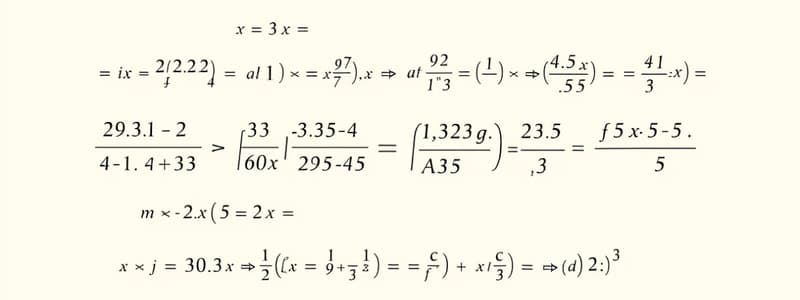Podcast
Questions and Answers
What does 'domain' refer to in functions?
What does 'domain' refer to in functions?
Input (x-values)
What does 'range' refer to in functions?
What does 'range' refer to in functions?
Output (y-values)
What is a 'one-to-one' function?
What is a 'one-to-one' function?
Each input has exactly one unique output.
What does 'onto' mean regarding functions?
What does 'onto' mean regarding functions?
What characterizes an 'onto/one-to-one' function?
What characterizes an 'onto/one-to-one' function?
What does 'discrete' mean in mathematics?
What does 'discrete' mean in mathematics?
What does 'continuous' mean in terms of functions?
What does 'continuous' mean in terms of functions?
What is the 'Vertical Line Test'?
What is the 'Vertical Line Test'?
What is 'function notation'?
What is 'function notation'?
What does it mean to 'evaluate' a function?
What does it mean to 'evaluate' a function?
What is the formula for a 'linear function'?
What is the formula for a 'linear function'?
What is a 'line of symmetry'?
What is a 'line of symmetry'?
What is a 'turning point' on a graph?
What is a 'turning point' on a graph?
What is a 'relative minimum' on a graph?
What is a 'relative minimum' on a graph?
What is a 'relative maximum' on a graph?
What is a 'relative maximum' on a graph?
What are 'zeros' in relation to a graph?
What are 'zeros' in relation to a graph?
What is an 'x-intercept'?
What is an 'x-intercept'?
What is a 'y-intercept'?
What is a 'y-intercept'?
What does 'positive' signify in a graph?
What does 'positive' signify in a graph?
What does 'negative' signify in a graph?
What does 'negative' signify in a graph?
What does 'increasing' mean regarding a function?
What does 'increasing' mean regarding a function?
What does 'decreasing' mean regarding a function?
What does 'decreasing' mean regarding a function?
What is 'end behavior'?
What is 'end behavior'?
What does 'continuity' refer to in functions?
What does 'continuity' refer to in functions?
What are 'extrema' in calculus?
What are 'extrema' in calculus?
What does 'symmetry' mean concerning graphs?
What does 'symmetry' mean concerning graphs?
Flashcards are hidden until you start studying
Study Notes
Functions and Continuity Concepts
- Domain: Refers to the set of all possible input values (x-values) for a function.
- Range: Represents all possible output values (y-values) produced by a function.
Characteristics of Functions
- One-to-one: Each input has a unique output; no two different inputs share the same output.
- Onto: Every possible output is associated with at least one input from the domain.
- Onto/one-to-one: Each input has a unique output, and each output corresponds to exactly one input, ensuring a bijective relationship.
Types of Functions
- Discrete: Consists of a finite number of separate points that are not connected.
- Continuous: Contains an infinite number of points that are connected, extending indefinitely in both directions.
Graphical Analysis
- Vertical Line Test: A method to determine if a curve is a function; if any vertical line intersects the graph more than once, it is not a function.
- Function Notation: Defined by replacing y with f(x); a way to express functions clearly.
- Evaluate: The process of substituting a specific value or expression for x in a function, often referred to as "Plug and Chug."
Linear Function
- Linear Function Equation: Represented by f(x) = mx + b, where m is the slope and b is the y-intercept.
Graph Characteristics
- Line of Symmetry: A vertical line that acts as a folding point, dividing the graph into two mirror-image halves.
- Turning Point: The point at which a graph changes direction, indicating local extrema.
- Relative Minimum: A point where the graph transitions from decreasing to increasing, representing a local low.
- Relative Maximum: Occurs when the graph changes from increasing to decreasing, indicating a local high.
Intercepts and Axes
- Zeros: Points where the graph intersects the x-axis; equivalent to x-intercepts.
- X-Intercept: The specific point(s) where the graph crosses the x-axis.
- Y-Intercept: The point(s) where the graph intersects the y-axis.
Function Behavior
- Positive: Regions of the graph lying above the x-axis indicate positive function values.
- Negative: Regions below the x-axis reflect negative function values.
- Increasing: Describes the trend where, as input values (x) increase, the function values (f(x)) also increase.
- Decreasing: Indicates that function values decrease as the input values increase.
Long-Term Behavior
- End Behavior: Describes the behavior of the function values as x approaches positive or negative infinity.
- Continuity: Refers to functions that are connected with no breaks, resulting in smooth curves or lines.
- Extrema: The maximum and minimum values of a function, outlining the highest and lowest points on a graph.
- Symmetry: Refers to functions exhibiting a vertical line that divides the graph into two symmetrical halves.
Studying That Suits You
Use AI to generate personalized quizzes and flashcards to suit your learning preferences.




